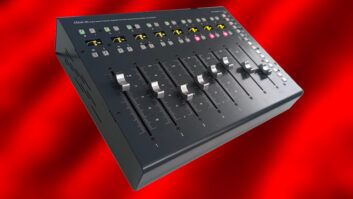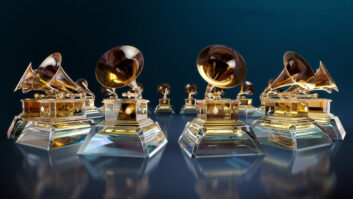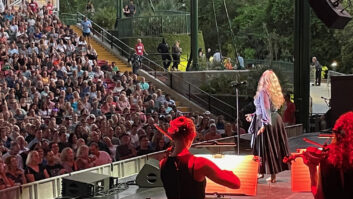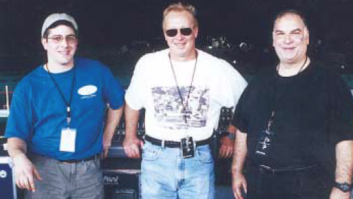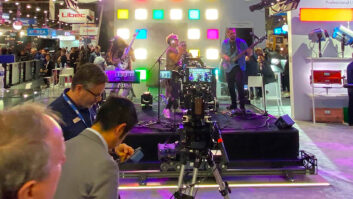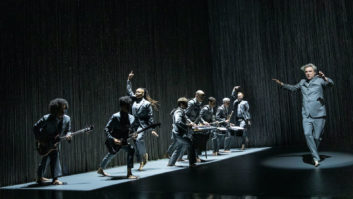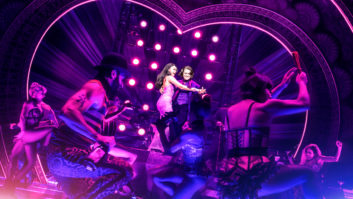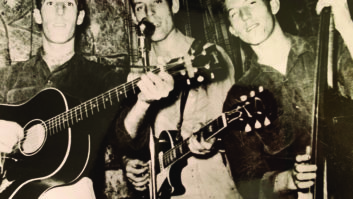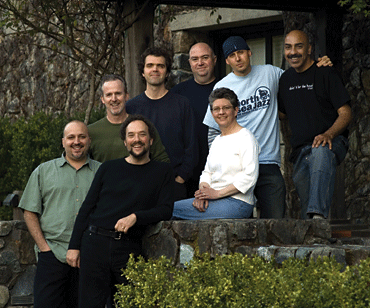

For 27 years now, the Los Angeles Guitar Quartet has been among the most respected chamber ensembles in this country, wowing classical music audiences with their incredibly rich and detailed ensemble work on pieces by composers old and new, while also drawing in many fans who know rock more than they know Bach, and who previously (and perhaps still) worship at the altar of various electric guitar gods. It’s telling that on their 2004 album, Heroes, the acoustic quartet paid tribute to everyone from John McLaughlin to Jimi Hendrix to Django Reinhart to Frank Zappa. These guys have deeply eclectic inclinations, serious chops and exquisite taste in both material and arrangements.
Like their excellent 2002 album, Latin, the quartet’s latest Telarc CD is a genre work: Brazil allows the foursome to tackle a wonderful cross-section of pieces by such legendary Brazilian composers as Antonio Carlos Jobim, Heitor Villa-Lobos and Hermeto Pascoal, as well as a number of writers well-known in guitar circles but perhaps not so much in the American mainstream: Marco Pereira, Raimundo Penaforte, Paolo Bellinati, Baden Powell and Clarice Assad, daughter of Sergio Assad of the Assad Brothers duo; Sergio Assad also arranged the CD’s Jobim medley. The LAGQ enlisted a few guests this time out, too: Brazilian singer/percussionist Luciana Souza appears on several tracks (she toured with the group before the album was recorded), Katisse Buckingham plays reeds and Kevin Ricard added percussion. There has also been a change in the core group. Last year, Andrew York left and was replaced by Matthew Greif, a longtime friend who fit in well immediately. He joins original members William Kanengiser, Scott Tennant and John Dearman — magnificent soloists and ensemble players.
Outside Skywalker Sound, L-R (front): Robert Friedrich, William Kanengiser, producer Erica Brenner; (back) John Dearman, Matthew Greif, Scott Tennant, reeds player Katisse Buckingham and percussionist Kevin Ricard
Photo: Gus Skinas
The Brazil album was recorded during three days in mid-May at Skywalker Sound in Marin County, Calif., the group’s first recording excursion there after several outings at O’Henry in L.A. “The Number One reason we ended up here is O’Henry closed down,” Kanengiser says during a break on the third day of sessions at Skywalker. “That being said, it’s so incredible to be here, and they’re putting us up at this inn over here — it’s kind of like going on vacation. We’ve never recorded before where we’ve had to leave town, and in a way it’s not great because we’re not home with family for a whole week, but the upside is we’re able to focus, and we’re getting lots of bonding time and it’s so nice up here. And it sounds really good, too.”
Out on the studio’s cavernous scoring stage, the LAGQ are tucked inside some wooden baffles at one end of the high-ceilinged room, warming up on the piece they’re about to record, the Brazilian pop standard “Mas Que Nada,” which was popularized by Sergio Mendes. Engineer Robert Friedrich, who has worked on all of the group’s Telarc recordings, makes some last-minute adjustments to his complex microphone setup, which combines close-miking with two arrays of overheads to capture the room and the overall sound of the ensemble.
“We’ve miked them differently on every [Telarc] record,” Friedrich says. “On the first one, we used tube M49s on the guitars; the second record we did four MKH 800s; the third record, Spin, we had stereo 800s on each of them. This time I’m using all these ribbon mics, which sound really good in this room.” Friedrich used Royer R-122s on each player and then two AEA R88s and two R84s as overheads. (“I also had some MKH 800s as overheads, but I ended up neglecting those when it came time to mix,” he tells me several months later.) Preamps included AEA TRPs, Sonic Lens 20/20-4s and Millennia HV-3Ds. He also used four tracks of EMT plates.
As with many Telarc projects, it was recorded to a Sonoma Direct Stream Digital (DSD) workstation with EMM Labs ADC and DAC converters custom-engineered by Ed Meitner. Gus Skinas, who operated the Sonoma, “drove out here from Colorado because he doesn’t want to ship his equipment,” Friedrich says. “He knows the Sonoma better than anybody.” The sessions were produced by Kanengiser and Telarc’s Erica Brenner, who had previously worked as a production supervisor and editor on other LAGQ releases, but not as the primary producer, a role previously occupied by Robert Woods.

“In some ways, this was a producer’s dream to record,” Brenner comments, “because so often you go into a studio with an artist or a group that’s just come up with their concept and they’re practicing the tunes right up to the session and then they tour the album right after. We had the benefit of them touring this for months with Luciana, so they had this feel about the music and they were very well-prepared when we went in to record.”
On my afternoon at Skywalker, the group runs through a nearly perfect rehearsal of “Mas Que Nada” as a quartet, then Katisse Buckingham and his alto flute arrive and the recording begins in earnest. They do a couple of takes — both of which sound perfect to my admittedly untrained ears — each ending with a fantastic improvised flute flight. Later, Kevin Ricard arrives and lays down a pair of percussion tracks, adding some pepper to the already rhythmic piece.
When Kanengiser and I talk again in late summer, I marvel that the group manages to capture the casual swing of Brazilian samba while maintaining their incredible precision as a quartet. “We were a little nervous about that from a playing standpoint,” he says, “because we’re not Brazilian and the guys who are the specialists in it have done it their entire lives — it’s in their blood. So right from the beginning, the idea was, ‘Let’s ask our friends who are experts in this to help us.’ ‘What can we do to learn from you guys?’ There’s a breezy element, especially to the melodic stuff, but the rhythmic precision of the accompaniment and the groove is absolutely unrelenting, so it takes a certain kind of attack — a right-hand percussiveness that’s a little more edgy than the traditional classical guitar feel. With classical guitar, refinement of tone is so important, but at times we deliberately tried not to get it on this project. You want it to slap a little bit and you want your short notes to be exaggeratedly short to get that funky groove. I’ve listened to the Assad Brothers play for 20 years and I have a pretty good idea of how they sound, and that’s what we were really trying to imitate at times.”
Using percussion overdubs was a first for the LAGQ; traditionally, they have tracked everything completely live (though edited from multiple takes of portions later). “He would record live [with the group] and then go back and record extra passes,” Friedrich says. “We had to build a lot of the percussion tracks in post.”

The L.A. Guitar Quartet at Skywalker Sound, May 2007. From left: Matthew Greif, John Dearman, engineer Robert Friedrich (standing), Scott Tennant and William Kanengiser
Photo: Gus Skinas
“I guess you’d say we took a slightly more pop approach; more crossover in nature,” Brenner adds. “It’s a slightly tighter sound and there was a more multichannel approach.”
Asked about the project’s pop crossover nature, Kanengiser offers, “It’s arguable that some of the repertoire is definitely more in the pop sensibility than some of the classical material we’ve recorded. But it runs the gamut — that Villa-Lobos piece we did is completely classical chamber music by any definition. But my arrangement of ‘Mas Que Nada’ is definitely pop; it’s a pop tune and we do it in a pop way, even though I try to throw in a couple of inside jokes that make it a little more toward the chamber music side. But that’s how our albums seem to go; hopefully, we’re not exactly 100-percent one thing or the other.”

Singer Luciana Souza had a blanket draped over her shoulder to separate her voice from the hand percussion she was playing.
Photo: Michael Norwood
After three days of tracking at Skywalker, the long post-production process began, starting with Kanengiser going through all the performances and making his editing decisions. “There was something very liberating about it for me, because in the old way of doing it we’d go to the studio and record, and then months later we’d get an edited version and then we’d be asked what needs to be fixed, and we would say, ‘In measure 6 there’s a wrong note, and in measure 10 we’re not together, and in measure 12 we’re out of tune.’ And they would search around and try to fix it and then they’d send it back, and say, ‘Is this better now?’ It’s a whole different thing to hear all of the raw tracks and have the opportunity to go compare all 20 takes of measures 1 through 7, and say, ‘This take has got the absolute best groove; it’s got every single thing happening that we want to have happen.’”
Producer Brenner had her own opinions about performance anomalies, too, and then did the hands-on editing on a Sonoma at Telarc’s Ohio headquarters. “It’s fast, it’s clean and you can do some amazing edits that sound seamless,” she says. “I wish more people understood the power of DSD.”
This release also has a multichannel version that Friedrich prepared for during tracking. “This surround is the way I’ve always wanted to approach surround with them but I’ve never had the right microphones or opportunity to do it,” he says. “I put them in the four corners, which is a really fun approach that lets you hear each player really well.”
What’s next for the prolific group? “The general consensus seems to be that maybe we’ve gone a little too long without making a classical album,” says Kanengiser. “If you just look at what we record, you might think we almost never play classical music, but if you come to our concerts, the first half is usually completely classical. It’s just market-driven that our last two record companies want to highlight the crossover stuff. It’s not 100-percent sure, but we might do a Bach record next — get back to our roots a bit.”

LISTEN: Must Play
Mas Que Nada
